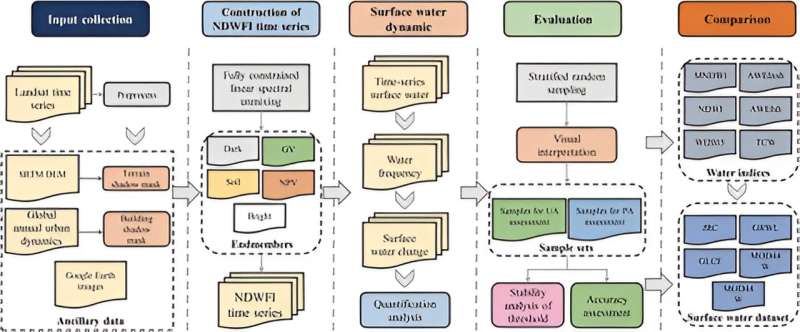This article has been reviewed according to Science X's editorial process and policies. Editors have highlighted the following attributes while ensuring the content's credibility:
fact-checked
proofread
New method for tracking water bodies improves security against extreme events

Surface water (SW) is crucial for life, ecosystems, and human activities, serving many functions from climate regulation to supporting biodiversity and agriculture. It's highly dynamic, influenced by climate change, land use alterations, and human interventions such as dam construction, making its monitoring essential for effective management and conservation.
Traditional methods for water detection face limitations, often missing small or seasonal bodies. Advances in remote sensing offer new techniques for detailed, large-scale water mapping, emphasizing the need for high spatial and temporal resolution to capture SW's complex dynamics and support sustainable management efforts.
Sun Yat-Sen University researchers developed the Normalized Difference Water Fraction Index (NDWFI) using Landsat and Spectral Mixture Analysis on Google Earth Engine, a leap in hydrology. This method enhances tracking of water bodies, improving water security against extreme events.
The article, published in the Journal of Remote Sensing on February 21, 2024, signifies progress in water management by integrating remote sensing and environmental science.
In this study, researchers developed the NDWFI by utilizing Landsat imagery and Spectral Mixture Analysis (SMA) within the Google Earth Engine framework. The technique was meticulously tested across varied terrains, exhibiting a remarkable 98.2% accuracy rate in identifying water bodies, a significant improvement over traditional water detection methods.
The use of more than 11,000 Landsat images facilitated the creation of detailed surface water maps for Jiangsu Province, China, showcasing NDWFI's ability to discern even the smallest and most transient water features. This method's enhanced precision in capturing the intricacies of water body dynamics marks a crucial advancement in the field of hydrological monitoring, setting a new standard for water resource management and conservation efforts worldwide.
Professor Qian Shi, a lead author of the study, stated, "Our approach using NDWFI significantly improves the accuracy of water detection, especially for small and transient water bodies, which are often overlooked by traditional methods. This advancement opens new avenues for comprehensive hydrological studies and water management strategies."
The NDWFI method presents a significant leap forward in environmental monitoring, offering a more accurate and detailed understanding of SW dynamics. This methodology enhances water security, supports sustainable development, and aids in the adaptation to climate change by providing reliable data for water resource management and policy-making.
More information: Yaotong Cai et al, Spatiotemporal Mapping of Surface Water Using Landsat Images and Spectral Mixture Analysis on Google Earth Engine, Journal of Remote Sensing (2024). DOI: 10.34133/remotesensing.0117
Provided by TranSpread





















